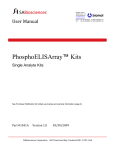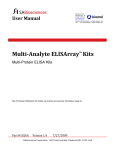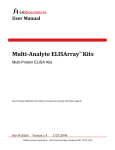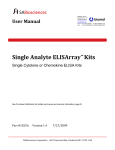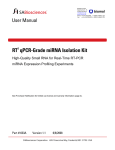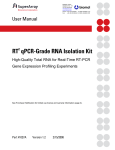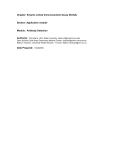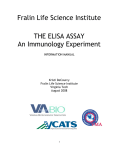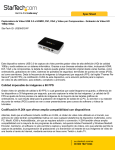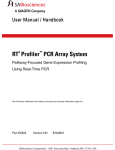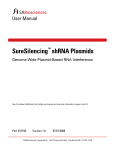Download User Manual - Biomol GmbH
Transcript
BIOMOL GmbH Waidmannstr. 35 22769 Hamburg [email protected] www.biomol.de Phone:+49-40-8532600 or 0800-2466651 (D) Fax: +49-40-85326022 or 0800-2466652 (D) User Manual PhosphoELISArray™ Kits Multi-Analyte Kits See Purchaser Notification for limited use license and warranty information (page 3). Part #1042A Version 1.0 3/30/2009 PhosphoELISArray™ Kit Multi-Analyte Kits User Manual (For Catalog Numbers Prefixed by FEM-######A) Ordering and Technical Service Contact Information: Tel: Fax: On-line Order: E-MAIL: BIOMOL GmbH Waidmannstr. 35 22769 Hamburg [email protected] www.biomol.de Phone:+49-40-8532600 or 0800-2466651 (D) Fax: +49-40-85326022 or 0800-2466652 (D) 1-888-503-3187 (US) 301-682-9200 (outside US) 1-888-465-9859 (US) 301-682-7300 (outside US) www.sabiosciences.com [email protected] (to place an order) [email protected] (for technical support) You may place orders by fax, e-mail or from our website. Each order should include the following information: Your contact information (name, phone, email address) Product name, catalog number and quantity Purchase order number or credit card information (Visa or MasterCard) Shipping address Billing address For more information, visit us at www.sabiosciences.com SABiosciences Corporation 6951 Executive Way Frederick, MD 21703 USA CONTENTS I. Background and Introduction 4 II. Materials Provided 6 III. Additional Materials Required 6 IV. Precautions 6 V. Complementary Products 6 VI. Protocol 7 A. Reagent Preparation 7 B. Cell lysate preparation 8 C. Assay Procedure 9 VII. Troubleshooting and Frequently Asked Questions 11 LIMITED PRODUCT WARRANTY This warranty limits our liability to replace this product in the event the product fails to perform due to any manufacturing defect. SABiosciences Corporation makes no other warranties of any kind, expressed or implied, including without limitation, warranties of merchantability or fitness for a particular purpose. SABiosciences Corporation shall not be liable for any direct, indirect, consequential or incidental damages arising out of the use, the results of use or the inability to use this product. NOTICE TO PURCHASER This product is intended for research purposes only and is not intended for drug or diagnostic purposes or for human use. Purchase of a PhosphoELISArray Kit does not grant rights to use or modify the kit components for resale or to use the PhosphoELISArray Kits to manufacture commercial products without written approval of SABiosciences Corporation. No other license, expressed, implied or by estoppels, is granted. U.S. patents may cover the use of certain antibodies included in the PhosphoELISArray Kit. Presently, it is not clear under U.S. laws whether commercial users must obtain licenses from the owners of the rights to these U.S. patents before using the PhosphoELISArray Kits.. 3 Multi-Analyte Profiler PhosphoELISArrays™ I. Background and Introduction The PhosphoELISArray Multi-Analyte Kits are designed to simultaneously profile the level of multiple analytes using the conventional and simple sandwich-based enzyme-linked immunosorbant assay (ELISA) technique. The 96-well ELISA microplate has been coated with a panel of eight target-specific capture antibodies, one in each twelve-well strip allowing you to obtain qualitative relative profiling results from up to twelve samples. (Figure 1 displays the typical layout of a catalogued PhosphoELISArray Kit.) Each kit also includes the corresponding detection antibodies, and a complete set of detection reagents for a colorimetric ELISA. The PhosphoELISArray kits provide a rapid, simple and cost-effective solution for the assessment of changes in relative phosphorylation for multiple protein targets. SABiosciences has screened commercially available antibodies to identify the capture and detection antibodies with the best sensitivity, best linearity and lowest background. All assays are optimized under uniform conditions to allow simultaneous detection with the same development or incubation time without compromising performance. Unlike other array-based technologies, the PhosphoELISArray kits enable the analysis of multiple protein targets without the need for special equipment. The PhosphoELISArray Multi-Analyte Kit uses a standard ELISA technique. (Figure 2 displays an overview of the assay protocol.) Incubation allows the capture antibodies to bind their specific protein of interest. After washing away unbound protein, detection antibodies added to the wells also bind the captured analyte. After washing again to remove unbound material, an HRP-linked secondary antibody is added. The wells are again washed and a colorimetric substrate solution is added, which produces a blue color in direct proportion to the amount of protein analyte present in the initial sample. The color development is stopped by adding stop solution, and the absorbance at 450 nm is read and compared across your samples. Benefits of the PhosphoELISArray Multi-Analyte Kit: • Multi-Protein Flexibility: Detect up to eight proteins at once using the same development or incubation time. • High Performance: Profile with the highest levels of sensitivity and linearity possible with screened and validated capture and detection antibodies. • Ease of Use: No special equipment is required, only the ELISA plate reader already in your lab. Technical Support: [email protected] www.sabiosciences.com 4 Version 1.0 1 2 3 4 5 Samples 6 7 8 9 10 11 12 A proteins B C D E F G H Figure 1: Layout of Cataloged PhosphoELISArray Kits All wells of a twelve-well strip are coated with the same capture antibody for the same protein. A set of eight strips in one PhosphoELISArray microplate therefore represents eight proteins. See the information for the specific kit that you ordered for the list of proteins represented. The corresponding numbered wells of each strip will characterize the same biological sample. Each PhosphoELISArray microplate therefore characterizes up to twelve biological samples. 1. Prepare all reagents. Set up experimental samples and negative control. 2. Transfer 50 µl of samples into the appropriate wells of the PhosphoELISArray plate. Incubate 2 hours. 3. Wash three times. 4. Add 50 µl Detection Antibody Solution. Incubate 1 hour. 5. Wash three times. 6. Add 50 µl HRP-linked secondary antibody. Incubate 1 hour. 7. Wash four times. 8. Add 50 µl Development Solution. Incubate 20 minutes in the dark. 9. Add 50 µl Stop Solution. Read OD 450 within 30 minutes. Figure 2: PhosphoELISArray Multi-Analyte Kit Procedure. Total Time ~ 4.5 hours Technical Support: 888.503.3187 (US) 301.682.9200 5 PhosphoELISArray™ Multi-Analyte Kit II. Materials Provided: Component / Description Coated Plate Detection Antibody Secondary Antibody (anti-rabbit IgG) Secondary Antibody (anti-mouse IgG) Sample dilution buffer Wash Buffer (10× Concentrate) Cell Extraction Buffer Development Solution Stop Solution Phosphatase/Protease Inhibitor Cocktail Quantity 1 plate One box of 8 1.5-ml tubes 1.5-ml tube 1.5-ml tube 60 ml bottle 80 ml in a 125 ml bottle 25 ml in a 30 ml bottle 12 ml in a 30 ml bottle 25 ml in a 60 ml bottle 250 l in a 1.5-ml tube Storage 4 °C -20 °C 4 °C -20 °C 4 °C 4 °C 4 °C 4 °C 4 °C 4 °C Storage Conditions: Reagents should be stored at 4 °C or -20°C upon receipt. Store any unused 12-well strips back into the pouch at 4 °C. When properly stored, the quality of each component is guaranteed for 6 months from the date received. Do not use kit beyond the expiration date printed on the label. III. Additional Materials Required: 1. Standard ELISA Microplate Reader Capable of measuring 450-nm absorbance with a 570-nm correction wavelength 2. Calibrated Multi-Channel Pipettor 3. Wash Bottle 4. Microcentrifuge Tubes 5. Laboratory Timer IV. Precautions 1. The Development Solution is toxic if inhaled or swallowed. Avoid contact with skin. Keep container tightly closed when not in use. 2. Stop Solution is an acidic solution. Wear eye, hand, face, and clothing protection when using this material. V. Complementary Products: PhosphoELISArray Single Analyte Kits Technical Support: [email protected] www.sabiosciences.com 6 Version 1.0 VI. Protocol: Please read through this entire protocol before beginning your experiment. A. Reagent Preparation: 1. All PhosphoELISArray Kit Reagents: Bring all reagents to room temperature before use. Once finished with each reagent in turn, immediately return to its proper storage conditions. 2. Wash Buffer: Dilute 50 ml of Wash Buffer Concentrate into de-ionized or distilled water (dH2O) to a final volume of 500 ml. 3. 1× Cell Extraction Buffer: Add 250 l of Phosphatase/Protease Inhibitor Cocktail to 25 ml of Cell Extraction Buffer just before using. B. Cell Lysate Preparation: 1. Aspirate media. Treat cells by adding fresh media containing regulator for desired time. 2. To harvest cells under non-denaturing conditions, remove media and rinse cells twice with ice-cold PBS. 3. Remove PBS, and add 0.5 ml ice-cold Cell Extraction Buffer with Phosphatase/Protease Inhibitor Cocktail to each culture dish (10 cm in diameter, 70-80% confluent) and incubate the plate on ice for 10 minutes with vortex at 3 minutes intervals. 4. Scrape cells off the plate and transfer to an appropriate tubes. 5. Microcentrifuge at 14,000 rpm for 10 minutes at 4 °C. 6. Aliquot the clear lysate to clean tubes. These samples are ready for the assay. Lysates are stored at -80 °C. Avoid multiple freeze/thaw cycles. C. Assay Procedure: The following recipes are designed for processing eight of the provided 12-well strips. If processing less or more strips at the same time, scale down or up the recipes appropriately. 1. Place the required strips in the strip holder. Unused strips must be resealed and stored at 4 °C immediately. 2. Add 50 µl of cell lysate and diluted cell lysate using sample dilution buffer into the appropriate well. Generally, lysate should make a series of 2-fold dilutions. However, dilution factors need to be titrated when specific cell lysate are used. Technical Support: 888.503.3187 (US) 301.682.9200 7 PhosphoELISArray™ Multi-Analyte Kit 3. Seal with tape and press firmly onto top of microwells. Incubate the plate for 2 hours at room temperature. Alternatively, the plate can be incubated overnight at 4 °C that gives the best detection of target protein. 4. Gently remove the tape and wash wells: Decant or aspirate the contents of the wells. Wash wells by filling with 350 µl of Wash Buffer. Gently shake or tap the plate for 10 seconds to mix and follow by decanting or aspirating the solution. Blot the strips upside down on absorbent paper to remove any residual buffer. Repeat twice for a total of three washes. 5. Prepare dilute Detection Antibodies just before the next step: a. Add 665 L of sample dilution Buffer to each tube of Detection Antibody. b. Mix well but gently. c. Transfer each detection antibody to its own empty tube of the Detection Antibody Dilution Tube Strip. d. Be sure to add the Detection Antibodies to the tubes in the same left-to-right order as the capture antibodies in rows 1 through 8. See the Product Specification Sheet for the correct orientation. 6. Using an 8-channel pipettor, transfer 50 L of the dilute Detection Antibodies from the Dilution Tube Strip to the appropriate rows of the PhosphoELISArray plate. Cover the plate and gently shake or tap the ELSArray plate for 10 seconds to mix. Incubate for 1 hour at room temperature on your bench-top. NOTE: Be sure to correctly orient your Detection Antibody Dilution Tube Strip above row A of the PhosphoELISArray plate to transfer the correct Detection Antibody to its correct wells. 7. Wash wells as in step 4. 8. Prepare secondary antibody Anti-rabbit IgG: add 344 µl of anti-rabbit IgG to a final volume of 5.5 ml with sample dilution buffer Anti-mouse IgG:.add 5.5 µl of anti-mouse IgG to a final volume of 5.5 ml with sample dilution buffer 9. Add 50 µl of secondary antibody to all wells. Incubate for 1 h at room temperature. 10. Wash wells as in step 4, except for a total of 4 washes. 11. Add 50 µl of the Development Solution to each well. Incubate the plate for 20 min or longer time until the strongest staining well turns to dark blue at room temperature in the dark. 12. Add 50 µl of Stop Solution to each well. Shake gently for a few seconds. The color in the wells should change from blue to yellow. 13. Wipe underside of wells with a lint-free tissue. Read absorbance at 450 nm within 30 min of stopping the reaction. If wavelength correction is available, subtract readings at 570 nm from the reading at 450 nm. Technical Support: [email protected] www.sabiosciences.com 8 Version 1.0 VI. Troubleshooting and FAQs For troubleshooting or other questions, please contact a Technical Support representatives by phone at 1-888-503-3187 or 301-682-9200 or by email at [email protected]. Technical Support: 888.503.3187 (US) 301.682.9200 9 PhosphoELISArray™ Multi-Analyte Kit Notes: Technical Support: [email protected] www.sabiosciences.com 10 Version 1.0 Technical Support: 888.503.3187 (US) 301.682.9200 11 PhosphoELISArray™ Multi-Analyte Kit User Manual Part #1042A Version 1.0 3/30/2009 BIOMOL GmbH Waidmannstr. 35 22769 Hamburg [email protected] www.biomol.de Phone:+49-40-8532600 or 0800-2466651 (D) Fax: +49-40-85326022 or 0800-2466652 (D)












